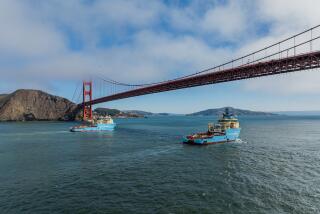On a sea of trash
On the first of June, two men and a rabbit set sail from the port of Long Beach, bound for Hawaii, on a raft made of junk. Their cabin is the cockpit of a Cessna 310, white with a blue racing stripe, salvaged from the desert. It floats on a system of handmade pontoons -- 15,000 plastic bottles held together with recycled nets -- propelled by currents and wind. If it sounds dangerous and makeshift, that’s the point. The pilots of Junk, as the vessel is called, want to get your attention.
They are Dr. Marcus Eriksen, director of research and education at the Algalita Marine Research Foundation in Long Beach, and Joel Paschal, a former employee of the National Oceanic and Atmospheric Administration. (The rabbit was abandoned early on -- to a safe home, not the depths -- after proving a less than seaworthy companion.) Their cause is alerting the world to the fouling of our oceans by plastic debris, and Junk is the poster child ( www.junkraft.com).
Plastic flotsam -- 100 million tons of it -- already litters the oceans of the world. Another 60 billion tons of plastics will be produced this year alone. A particularly dense accumulation of debris can be found in a holding pattern 1,000 miles off the California coast, in an area known as the central North Pacific gyre, the calm core of a convergence of four major ocean currents rotating clockwise under a large high-pressure zone. What gets in there can be trapped for decades.
The buildup of plastics in the gyre is estimated to span 5 million square miles. That’s the equivalent of the area of the United States -- all 50 states -- plus India. Some of the debris at the surface floats, some is “neutrally buoyant,” suspended just below the waves, and some hovers even deeper. Some is apparent and recognizable -- water bottles, balloons, degraded buoys -- but over time, these objects break down into smaller and smaller plastic pieces until they become particulate, invisible to the naked eye. (And small enough to be ingested by fish and filter feeders, as the larger pieces are by birds and turtles.) Also, the central gyre is so vast that even a devastating quantity of visible debris will appear relatively diffuse. There’s no observable “plastic island,” no obvious “garbage patch.”
To study the plastics in the gyre is costly and time consuming. Sailing through the region, a journey that can only be undertaken at certain times of the year, takes a full month. Eriksen and Paschal made their first gyre voyage in January, captained by Algalita founder Charles Moore, who has studied the area for more than a decade. Moore’s work has shown that, in parts of the central gyre, plastics outweigh surface zooplankton 6 to 1. Put bluntly: That’s more trash than life. As Moore puts it, “The constituency of ocean water has been fundamentally altered.”
For many, it’s hard to feel for slimy protozoans the way we do for a polar bear drifting on an orphaned block of ice. But we should. Plankton, salps, jellyfish -- these are fundamental creatures of the sea. You might say the effects of plastic flotsam are like the flotsam itself: Some are visible -- the 100,000 marine mammals killed each year, carcasses of Laysan albatross full of colored bottle tops and lighters -- but, all the more sinister, some are not.
Certain plastic resins contain potentially toxic additives, such as bisphenol A, that can leach into surrounding water. They serve as magnets for toxic substances already present in the water, such as PCBs and DDT, which accumulate as they move up the food chain. Particles of plastic also act as hosts for invasive species, carrying them to new regions of the sea, further upsetting the marine ecosystem.
About 80% of the plastic debris in the oceans gets there from land. It isn’t dumped off ships. Rather, it washes from our beaches and streets and highways, through storm drains and into streams and rivers. According to a 2006 article in this newspaper, the trash that flows down the Los Angeles River each year would fill the Rose Bowl two stories high.
California’s State Water Resources Control Board defines “trash” as debris that can be caught by a 5-millimeter mesh screen, but much of the plastic that enters the ocean is smaller than that. Most common are beads of polystyrene and “nurdles,” pre-production plastic pellets overlooked during the manufacturing process. What’s worse, in a 2005 study of local plastics industry work sites, Moore found that screens on storm drains, where present, were frequently removed during rain -- when debris moves most quickly toward the sea -- to prevent flooding. Screens are not enough. Plastic litter must be stopped at its source, not on the brink of a watershed.
Eriksen and Paschal know this, and they want you to know it too. Junk hasn’t made it very far as yet, delayed by bad weather and subsequent repairs (the ocean had managed to unscrew hundreds of caps from the bottles), but now they’re back on course, leaving Guadalupe Island off the coast of Baja California, and hoping that you’ll tell a friend.
More to Read
Sign up for Essential California
The most important California stories and recommendations in your inbox every morning.
You may occasionally receive promotional content from the Los Angeles Times.










